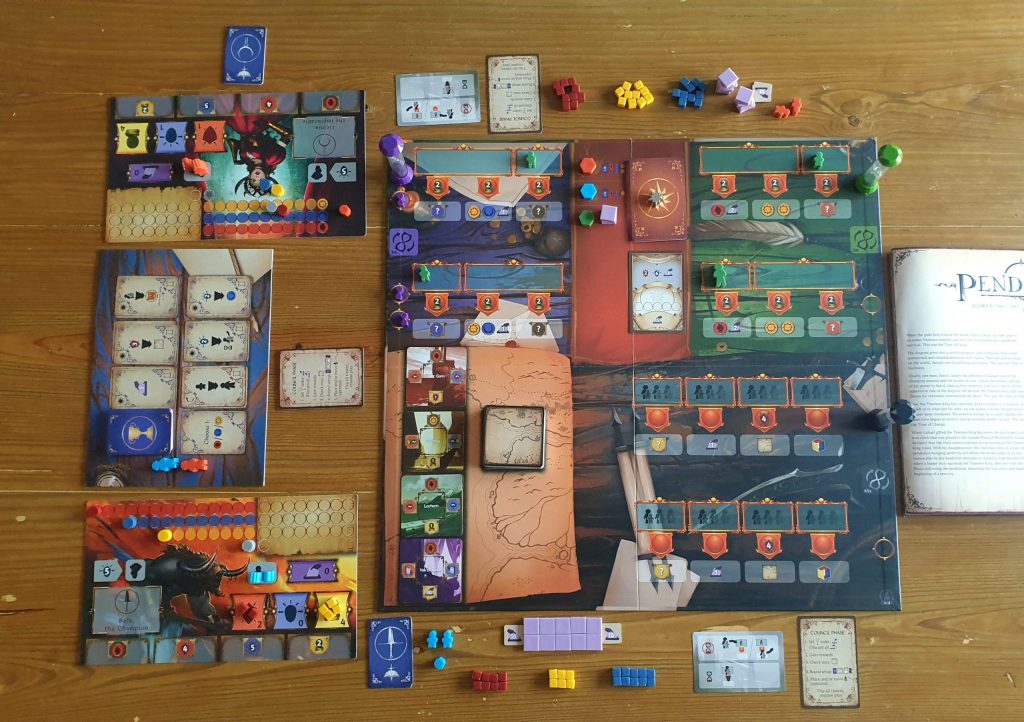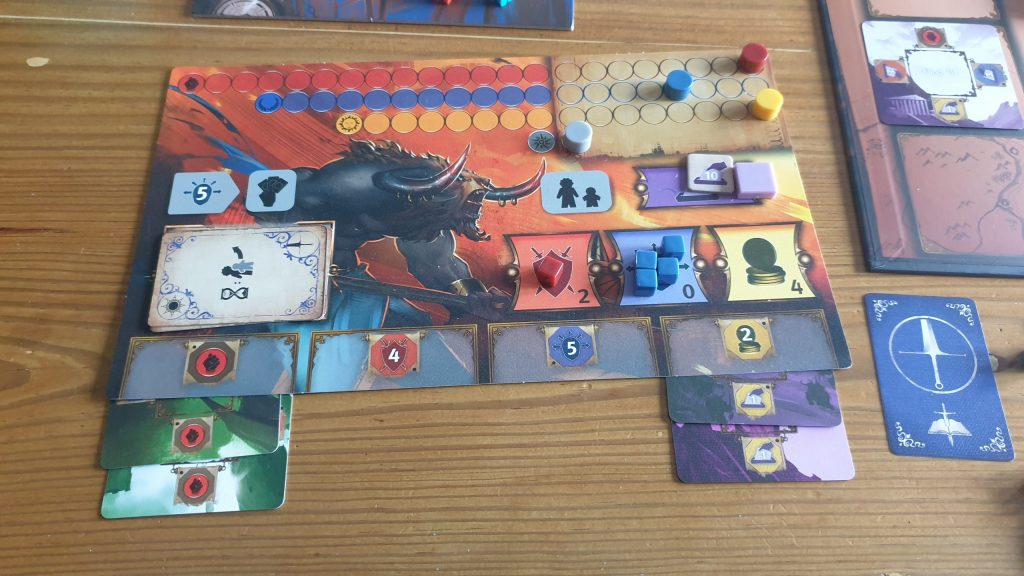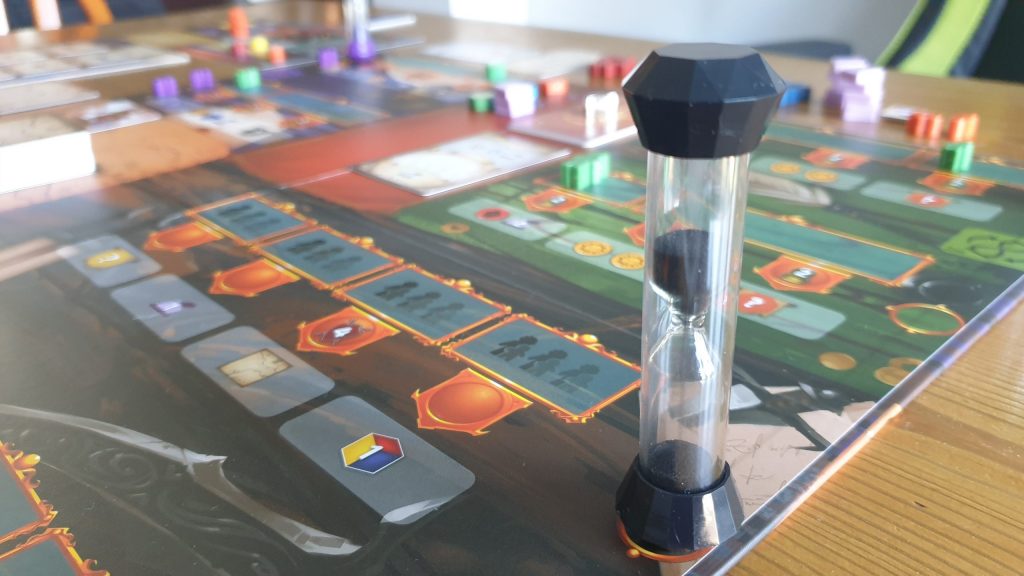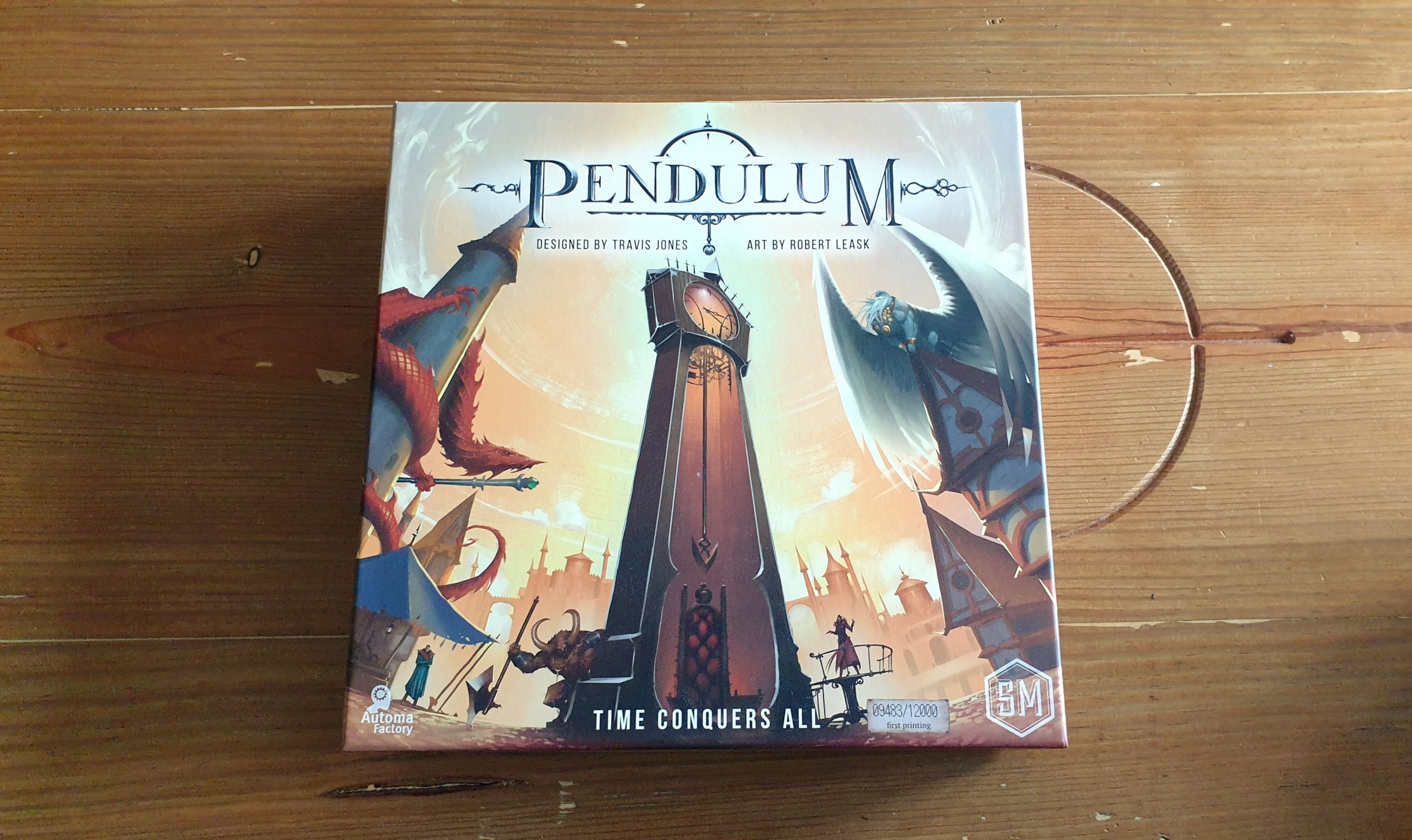Pendulum is a brand new real time, worker placement, game from publisher Stonemaier Games. Designed by Travis P. Jones, the game sees 1 – 5 players take up the roles of nobles attempting to succeed the Timeless King. With actual time at their disposal, players will gain power, rise in popularity and prestige, all while being efficient. Taking just over an hour to play there are sand timers, lands to conquer and more. However, will players want to visit Dünya, let alone try to rule it? Let’s find out!
As nobles, players are aiming to be the only one to increase their power, prestige and popularity enough, and to perform a legendary achievement. These are obtained by taking actions over the course of 4 real time rounds, with a non-real time council phase after each. As the sand timers tick, players will be using their workers to perform actions. Unlike in most worker placement games the reward isn’t gained instantly, and spaces are periodically blocked by sand timers.
The crux of Pendulum is that workers can be sent to action spaces on rows without sand timers, and be freely moved from these rows while the sand timer isn’t there. When a sand timer is in a row workers can no longer be added or removed. However, workers already there can then, and only then, be used to trigger the associated action. This is how players will gain resources or trigger their production slots. These can, in turn, be used to move their victory point markers up the power, popularity and prestige tracks. When flipped a sand timer cannot be touched until it has finished running. Importantly, at this stage it is up to the players around the table to flip it. So, it could stay in a location simply blocking the row, ready to be flipped to the other row.
On top of the timers other players can block action spaces. While none of the 45 second timer spaces can be blocked, the rest are half blocked when a worker is sent there. Players start with a common and a grande worker. Common workers can only be sent to free spaces, while the grande meeples can be sent to any action spaces – even those with other grande workers. This works very similarly to the grande workers in Viticulture – one of the other Stonemaier Games titles.

The three main resources open up different routes to players. Instead of there being one central bank each player has ten cubes of each, with them never able to gain more than these ten to use. Gold is the easiest to come, as it is commonly earnt by triggering a player’s yellow banner production. It’s easiest, or at least quickest, as this action is in the 45 second timer section of the board. Gold is needed for the 2 and 3 minute timer areas. To perform any of those actions will cost 2 gold, on top of the extra time spent.
For the basic characters, culture is the way to pay to pick up used stratagem cards. These cards can be played to instantly gain a benefit. Some of these cards are earnt during play, though each character starts with 4 unique to them. These range from a victory point or a resource through to spending resources for an additional worker or to remove a worker from a row with a sand timer. This can make culture a very valuable resource. However, its use changes when advanced characters are used – as they don’t rely on culture for stratagem cards.
Military is the most thematic resource. The only 45 second timer action to have a cost is the claim a province tile space, costing 4 military cubes. Very easily this can be seen as using military might to conquer a province. These province tiles slide underneath the player board upgrading one of the four production banners. When triggered these banners then produce what is on them and the province tiles below. This is often the way players will gain large amounts of resources, though they can also trigger victory points and votes.
The three minute timer has two uses. Not only does it open and close the action rows for the three minute zone, it triggers the end of the round. Each time it is flipped it knocks a time token off the side of the board. When the timer hits the final time token the end of the round is called, though players can finish any actions they are able to do without moving timers. When the round ends players enter the council phase, starting by counting their votes. The player with the most votes moves to the top of the privilege tracker. Bonuses are then awarded based on the positions on the tracker. Everyone will gain a new stratagem card, though victory points are also up for grabs.

At the end of the council phase there is a bit of clean up, such as refreshing the available stratagem cards for the next council phase. The final council phase has a specific set of these cards that are focused more towards points, with 1 opportunity to gain a legendary achievement. At this point, if only one player has got all four of their point markers into the parchment zone then they win, becoming the new Timeless Ruler. If multiple players have managed this then ties are split by whoever has the most victory points. Interestingly, if none of the players have managed a legendary achievement then no one wins!
Unlike other real time games where things feel constantly rushed – as if the game was shouting “Go Go Go!” – there are peaks and troughs in Pendulum. More so with the 45 second timer you can quickly place workers and soon activate them – though it’s never hectic chaos. Times when waiting for a timer aren’t lulls either. These are opportunities to take a breather, a step back, and plan ahead. Those that suffer from analysis paralysis can still be flustered though, as if you keep missing the timings your opponents may be pulling ahead.
The size of the Pendulum rulebook is a tad misleading. While there are a few different elements, from the engine building of province tiles to the general real time worker placement, each aspect isn’t overly complicated. Whilst important it feels like half of the rulebook is dedicated to how the timers and placing meeples work. It can be a bit hard for new players in their first game, as it’s uncomfortable to ask questions while timers are ticking. Thankfully, they can be paused by turning them onto their side. Similar to Architects of the West Kingdom, Pendulum has built in variety that helps the game grow with players. After a game or two, players can flip the player mats to an advanced side. These come with different starting resources, unique production banners and character specific stratagem cards. These advanced characters are more focused on specific things, though even the standard characters have minor variations between them.
A few aspects, such as breaking ties, are left up to the group. Rulebooks not being specific is a bit of a bugbear of mine normally. In this case, it allows different groups to decide on quite how strict to be. There is always the privilege order to fall back on but whether players can be a split second late can be decided ahead of time. The important aspects of stopping players snowballing have been taken care of though, with no wiggle room there. This is evident as the province tile engine building can be a strong way to gain a lot from a single action. While annoying to those exploiting production, it makes sense that players are forced to discard down to two province tiles per column in the council phase. Simply it stops someone becoming a runaway leader.

Theme is something that Stonemaier Games is strong at. Viticulture had all the steps of making wine, Scythe had the incredible world of alternate 1920s and Wingspan was filled to the brim with birds. Tapestry was a little weak and Pendulum is another title from the publisher with a weak theme. Before the game has begun, during the teaching, prestige quickly becomes blue, power becomes red and popularity yellow. The legendary achievement is the only one to stand out but only as it is the unique one. The theme doesn’t help players make sense of actions and then there are even dragons thrown into the lore, seemingly for fun.
For the most part the components of Pendulum are solid without being spectacular. Most of the tokens are plastic, with the colours used making them easily distinguishable. The legendary achievement token is by far the nicest token, being metal it stands out from the regular tokens. The province tiles feature artwork, though they are heavily saturated colour wise making the art blur into nothingness. Pendulum uses a range of symbology, which once learnt are easy to read. Still, this learning process would have been simpler if gold was represented by yellow cubes, not gold coins – especially as token wise yellow cubes are used for gold.
It had been pointed out by others so I timed the sand timers. The black 45 second timer was pretty much to the exact second, so things looked promising. As the timer lengths increased though they drifted further from the mark. The 2 minute green timer averaged around 1:56 and the purple 3 minute timer averaged about 2:52. It isn’t exactly an issue as everyone involved is playing with the same conditions, but it seems that games of Pendulum with my copy could perceivably be shorter than others, though only by around a minute – and that is if the purple sand timers were always flipped instantaneously. In fact the bigger issue with the purple sand timer is not the lost 8 seconds. In the purple timer is very fine sand and therefore in anything less than a well lit room it can be hard to visually see that the sand timer is actually going.
None of the core mechanics in Pendulum are new individually, yet combined they do create a unique feeling experience. As with many Stonemaier Games titles there is an efficiency puzzle at the core of Pendulum, and time is very much part of that. Regular worker placement gameplay is there, though it is spiced up with there being no distinct turns and the pressure of the sand timers ticking. Some will thrive with this pressure to think quickly. There is an option to remove the sand timers, though this is what makes Pendulum stand out, it certainly isn’t the theming that will attract players. Regardless of the unique feel and the nice waves of action throughout the real time aspect will continue to be a bit divisive. Therefore, Pendulum is one to try before you buy, though it will be sticking around on my gaming shelf!
(Editor’s Note: Pendulum was provided to us by Asmodee for the review. The game is currently available from local board game stores! Find your local store here.)

